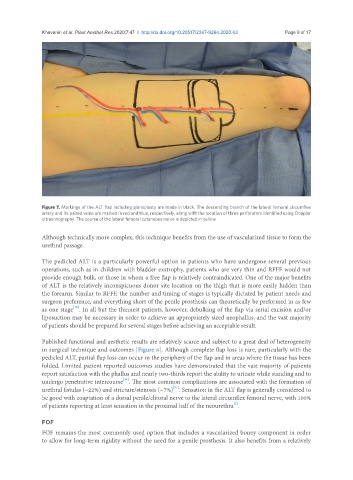Page 538 - Read Online
P. 538
Khavanin et al. Plast Aesthet Res 2020;7:47 I http://dx.doi.org/10.20517/2347-9264.2020.63 Page 9 of 17
Figure 7. Markings of the ALT flap including glansplasty are made in black. The descending branch of the lateral femoral circumflex
artery and its paired veins are marked in red and blue, respectively, along with the location of three perforators identified using Doppler
ultrasonography. The course of the lateral femoral cutaneous nerve is depicted in yellow
Although technically more complex, this technique benefits from the use of vascularized tissue to form the
urethral passage.
The pedicled ALT is a particularly powerful option in patients who have undergone several previous
operations, such as in children with bladder exstrophy, patients who are very thin and RFFF would not
provide enough bulk, or those in whom a free flap is relatively contraindicated. One of the major benefits
of ALT is the relatively inconspicuous donor site location on the thigh that is more easily hidden than
the forearm. Similar to RFFF, the number and timing of stages is typically dictated by patient needs and
surgeon preference, and everything short of the penile prosthesis can theoretically be preformed in as few
[30]
as one stage . In all but the thinnest patients, however, debulking of the flap via serial excision and/or
liposuction may be necessary in order to achieve an appropriately sized neophallus, and the vast majority
of patients should be prepared for several stages before achieving an acceptable result.
Published functional and aesthetic results are relatively scarce and subject to a great deal of heterogeneity
in surgical technique and outcomes [Figure 8]. Although complete flap loss is rare, particularly with the
pedicled ALT, partial flap loss can occur in the periphery of the flap and in areas where the tissue has been
folded. Limited patient reported outcomes studies have demonstrated that the vast majority of patients
report satisfaction with the phallus and nearly two-thirds report the ability to urinate while standing and to
[31]
undergo penetrative intercourse . The most common complications are associated with the formation of
[31]
urethral fistulas (~22%) and stricture/stenosis (~7%) . Sensation in the ALT flap is generally considered to
be good with coaptation of a dorsal penile/clitoral nerve to the lateral circumflex femoral nerve, with 100%
[3]
of patients reporting at least sensation in the proximal half of the neourethra .
FOF
FOF remains the most commonly used option that includes a vascularized boney component in order
to allow for long-term rigidity without the need for a penile prosthesis. It also benefits from a relatively

